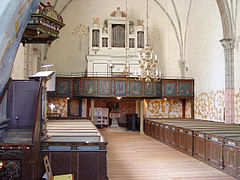Church of Bro
The Church of Bro (Bro kyrka) is a country church in Bro on the Swedish island of Gotland . It is located near Bro, 11 km northeast of Visby . It was a votive church , especially for sailors, and is said to have been built over an old sacrificial spring. In today's building, Romanesque and Gothic elements are mixed. The wall decorations and furnishings from different eras illustrate the changing times.
Church building
Only the tower still comes from the oldest church in the prehistorically interesting place in several respects. A Romanesque quarry stone church with a nave , apse choir and church tower was built around 1200 . A round-arched frieze, some fields of which were decorated with reliefs, ran around the roof of the nave. Remnants can be found in the south wall of the Gothic nave as spolia . In the middle of the 13th century, the current choir and sacristy were built, and towards the end of the century the single nave was built.
Inclusion
An inclusory was built in the corner between the west wall of the nave and the tower. Walled into the south wall or erected in front of it are the remains of three picture stones (one from the 5th century AD). The small room has a so-called hagioscope , a four-pass opening through which the inclusion could follow the Holy Mass . In the chamber there is a bird capital , which was originally an element in the double arch between the tower and the nave.
- Church of Bro
Sighraf's baptismal font
The portals
The early Gothic choir portal shows delicate tendrils and palmettes in bas-relief on the capitals created by Neoikonicus . The nave portal represents high Gothic in its Gotland-defining way. The capital figures on the left show scenes from the life story of Jesus as well as the resurrection and the realm of the dead, on the right there are stylized vegetal motifs. On the sculptures and in the tympanum one can still see traces of the medieval painting. The wooden door with its iron fittings dates from around 1300.
remodeling
The church was painted in 1686. The medieval wall paintings in the choir and in the nave vault were repaired. Attached are new motifs and the name of the Swedish King Charles XI . Some medieval paintings above the triumphal arch were whitewashed, but later exposed again. In the nave and choir, friezes were discovered by the so-called passion master from the 15th century. Uncovered remains can be seen on the south wall of the choir.
Facility
The central motif of the altarpiece of sandstone is the sacrament. The canopy of the pulpit painted by Jöns Wulff, dating from 1723, bears the monogram of King Fredrik I.
Furnishings of cultural and historical importance are:
- Baptismal font of master Sighraf from around 1200
- Triumphal cross from around 1200
- a bell from around 1500, inscribed in Low German
Bildstein
One of the outstanding picture stones with three vortex wheel motifs and the depiction of a rowing boat is walled in horizontally to the west of the south-western portal of the church. Its preserved length is 1.88 m. It is dated between 400 and 600 AD.
Sights in the vicinity
- Bro offerkälla (source of sacrifice) with grinding grooves
- Bro stenkalm, a large Roese ; not far from the Bro Oikar (ox), two menhirs
- Bildsteine Bro Stainkällingar (stone women)
literature
- Marita Jonsson, Sven-Olof Lindquist: Gotland cultural guide. Almqvist & Wiksell, Uppsala 1993, ISBN 91-88036-09-X , p. 99.
- Erland Lagerlöf, Gunnar Svahnström: The churches of Gotland. Stein, Kiel 1991, ISBN 3-89392-049-8 .
- Sigmund Oehrl: Gotland's picture stones. Problems and new ways of their documentation, reading and interpretation (= Studia archaeologiae medii aevi. 3). Likias Verlag, Friedberg 2019, ISBN 978-3-9820130-1-5 .
Web links
- guteinfo: Bro kyrka (Swedish)
- Organ different
- Väskinde församling
- Bro kyrka: Hagioskop (pictures)
- PaGotland ( Memento from August 30, 2010 in the Internet Archive ) (Swedish)
- Building register at Riksantikvarieämbetet (Swedish)
Coordinates: 57 ° 40 ′ 12.3 " N , 18 ° 28 ′ 28.9" E






